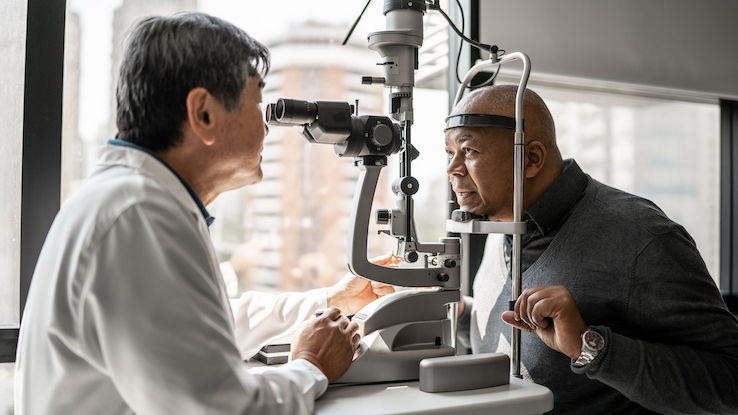
An estimated 12.6% of Americans aged 50 and older have age-related macular degeneration, an eye condition that can reduce visual acuity, create visual distortions, and lead to blindness. Among this age group, age-related macular degeneration is the leading cause of vision loss.
Overall, macular degeneration is pretty common, particularly as people get older. So, it’s wise to learn about the symptoms of the condition, as early detection and treatment can limit harm to your vision. Here’s what you need to know.
Symptoms of Macular Degeneration
In most cases, the symptoms of macular degeneration that people tend to notice first involve changes to their vision. Blurriness or fuzziness may occur, as well as distortions like straight lines looking wavy. Some also experience difficulty recognizing people’s faces, even among individuals they know.
Another sign of macular degeneration is requiring brighter light for detail or up-close tasks, such as reading or sewing. Adjusting to low-light conditions is also more challenging, such as walking into a dim space from a brighter one.
Usually, central vision is most dramatically impacted. Over time, macular degeneration can cause central vision loss, essentially creating a blind spot in the middle of the visual area.
Macular degeneration can occur in one or both eyes. As a result, whether one or both eyes is involved doesn’t preclude the condition from being macular degeneration.
How Is Macular Degeneration Diagnosed?
Generally speaking, diagnosing macular degeneration isn’t overly complicated or invasive. The exam will begin with a classic visual acuity test, allowing your eye doctor to determine whether you can see clearly and if there are any visual field changes. Your doctor might also assess your vision with an Amsler grid. This is a square with a grid pattern of lines in it and a dot in the center. Using this test lets your doctor check for visual distortions specific to macular degeneration, such as straight lines appearing wavy or if blind spots are developing.
An eye care doctor will typically conduct a dilated eye exam as well. Eye drops cause the pupil to dilate, which is painless and harmless. Once dilated, the doctor can examine the eye with greater ease, allowing them to spot changes that indicate macular degeneration.
An optical coherence tomography (OCT) is another procedure a doctor may use to diagnose macular degeneration. This approach takes images of the inside of your eye using a specially designed device. The images allow the doctor to look for various indications of macular degeneration.
Your doctor may also conduct a fluorescein angiography. This procedure involves injecting dye into your arm. When the dye reaches your retina, images are taken that help determine if there is abnormal vessel development or vessel leaks.
When Should You See a Doctor?
It’s best to see an eye care doctor whenever you notice any changes to your visual acuity, including blurriness, distortions, or blind spots. Additionally, if fine details aren’t easy to see, it’s wise to get an exam.
While the issues above aren’t always indicative of macular degeneration, determining the root cause quickly allows for prompt treatment. In turn, it’s easier to preserve your vision or take corrective action to restore clarity if that option is available.
The U.S. Preventive Services Task Force recently found that there was not enough evidence to support eye screening in patients without symptoms. But if you do notice any changes in your vision, that would be the time to visit a doctor.
Further Reading
- Rubia S, Kaufman EJ. “Macular Degeneration.” [Updated 2022 Aug 3]. In: StatPearls [Internet]. Treasure Island (FL): StatPearls Publishing; 2022 Jan-. Available from: https://www.ncbi.nlm.nih.gov/books/NBK560778/
- Centers for Disease Control and Prevention (CDC). “Prevlaence of Age-Related Macular Degeneration (AMD).” Last reviewed 31 Oct 2022. https://www.cdc.gov/visionhealth/vehss/estimates/amd-prevalence.html
- Stevens A. “Top Causes of Vision Loss and Blindness.” AARP. Published 04 Dec 2020. https://www.aarp.org/health/conditions-treatments/info-2020/causes-of-blindness.html
- Boyd K. “Have AMD? Save Your Sight with an Amsler Grid.” American Academy of Ophthalmology. Published 26 May 2020. https://www.aao.org/eye-health/tips-prevention/facts-about-amsler-grid-daily-vision-test
- U.S. Preventive Services Task Force (USPSTF). “Final Recommendation Statement: Impaired Visual Acuity in Older Adults: Screening.” Published 24 May 2022. https://www.uspreventiveservicestaskforce.org/uspstf/recommendation/impaired-visual-acuity-screening-older-adults





